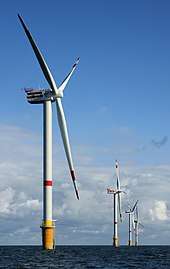Recycling
Recycling is the process of converting waste materials into new materials and objects. The recyclability of a material depends on its ability to reacquire the properties it had in its virgin or original state.[1] It is an alternative to "conventional" waste disposal that can save material and help lower greenhouse gas emissions. Recycling can prevent the waste of potentially useful materials and reduce the consumption of fresh raw materials, thereby reducing: energy usage, air pollution (from incineration), and water pollution (from landfilling).
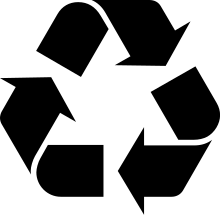
Recycling is a key component of modern waste reduction and is the third component of the "Reduce, Reuse, and Recycle" waste hierarchy.[2][3] Thus, recycling aims at environmental sustainability by substituting raw material inputs into and redirecting waste outputs out of the economic system.[4] There are some ISO standards related to recycling such as ISO 15270:2008 for plastics waste and ISO 14001:2015 for environmental management control of recycling practice.
Recyclable materials include many kinds of glass, paper, cardboard, metal, plastic, tires, textiles, batteries, and electronics. The composting or other reuse of biodegradable waste—such as food or garden waste—is also a form of recycling.[5] Materials to be recycled are either delivered to a household recycling center or picked up from curbside bins, then sorted, cleaned, and reprocessed into new materials destined for manufacturing new products.
In the strictest sense, recycling of a material would produce a fresh supply of the same material—for example, used office paper would be converted into new office paper or used polystyrene foam into new polystyrene. This is accomplished when recycling certain types of materials, such as metal cans, which can become a can again and again, indefinitely, without losing purity in the product.[6] However, this is often difficult or too expensive (compared with producing the same product from raw materials or other sources), so "recycling" of many products or materials involves their reuse in producing different materials (for example, paperboard) instead. Another form of recycling is the salvage of certain materials from complex products, either due to their intrinsic value (such as lead from car batteries, or gold from printed circuit boards), or due to their hazardous nature (e.g., removal and reuse of mercury from thermometers and thermostats).
History
Origins
Recycling has been a common practice for most of human history, with recorded advocates as far back as Plato in the fourth century BC. During periods when resources were scarce and hard to come by, archaeological studies of ancient waste dumps show less household waste (such as ash, broken tools, and pottery)—implying more waste was being recycled in the absence of new material.[7]
In pre-industrial times, there is evidence of scrap bronze and other metals being collected in Europe and melted down for continuous reuse.[8] Paper recycling was first recorded in 1031 when Japanese shops sold repulped paper.[9][10] In Britain dust and ash from wood and coal fires was collected by "dustmen" and downcycled as a base material used in brick making. The main driver for these types of recycling was the economic advantage of obtaining recycled feedstock instead of acquiring virgin material, as well as a lack of public waste removal in ever more densely populated areas.[7] In 1813, Benjamin Law developed the process of turning rags into "shoddy" and "mungo" wool in Batley, Yorkshire. This material combined recycled fibers with virgin wool.[11] The West Yorkshire shoddy industry in towns such as Batley and Dewsbury lasted from the early 19th century to at least 1914.
Industrialization spurred demand for affordable materials; aside from rags, ferrous scrap metals were coveted as they were cheaper to acquire than virgin ore. Railroads both purchased and sold scrap metal in the 19th century, and the growing steel and automobile industries purchased scrap in the early 20th century. Many secondary goods were collected, processed and sold by peddlers who scoured dumps and city streets for discarded machinery, pots, pans, and other sources of metal. By World War I, thousands of such peddlers roamed the streets of American cities, taking advantage of market forces to recycle post-consumer materials back into industrial production.[12]
Beverage bottles were recycled with a refundable deposit at some drink manufacturers in Great Britain and Ireland around 1800, notably Schweppes.[13] An official recycling system with refundable deposits was established in Sweden for bottles in 1884 and aluminum beverage cans in 1982; the law led to a recycling rate for beverage containers of 84–99 percent depending on type, and a glass bottle can be refilled over 20 times on average.[14]
Wartime



New chemical industries created in the late 19th century both invented new materials (e.g. Bakelite [1907]) and promised to transform valueless into valuable materials. Proverbially, you could not make a silk purse of a sow's ear—until the US firm Arthur D. Little published in 1921 "On the Making of Silk Purses from Sows' Ears", its research proving that when "chemistry puts on overalls and gets down to business ... new values appear. New and better paths are opened to reach the goals desired."[15]
Recycling (or "salvage", as it was then usually known) was a major issue for governments throughout World War II. Financial constraints and significant material shortages due to war efforts made it necessary for countries to reuse goods and recycle materials.[16] These resource shortages caused by the world wars, and other such world-changing occurrences, greatly encouraged recycling.[17] The struggles of war claimed much of the material resources available, leaving little for the civilian population.[16] It became necessary for most homes to recycle their waste, as recycling offered an extra source of materials allowing people to make the most of what was available to them. Recycling household materials meant more resources for war efforts and a better chance of victory.[16] Massive government promotion campaigns, such as the National Salvage Campaign in Britain and the Salvage for Victory campaign in the United States, were carried out on the home front in every combative nation, urging citizens to donate metal, paper, rags, and rubber as a matter of patriotism.
Post-World War II
A considerable investment in recycling occurred in the 1970s, due to rising energy costs.[18] Recycling aluminium uses only 5% of the energy required by virgin production; glass, paper and other metals have less dramatic but very significant energy savings when recycled feedstock is used.[19]
Although consumer electronics such as the television have been popular since the 1920s, recycling of them was almost unheard of until early 1991.[20] The first electronic waste recycling scheme was implemented in Switzerland, beginning with collection of old refrigerators but gradually expanding to cover all devices.[21] After these schemes were set up, many countries did not have the capacity to deal with the sheer quantity of e-waste they generated or its hazardous nature. They began to export the problem to developing countries without enforced environmental legislation. This is cheaper, as recycling computer monitors in the United States costs 10 times more than in China. Demand in Asia for electronic waste began to grow when scrap yards found that they could extract valuable substances such as copper, silver, iron, silicon, nickel, and gold, during the recycling process.[22] The 2000s saw a large increase in both the sale of electronic devices and their growth as a waste stream: in 2002, e-waste grew faster than any other type of waste in the EU.[23] This caused investment in modern, automated facilities to cope with the influx of redundant appliances, especially after strict laws were implemented in 2003.[24][25][26][27]
As of 2014, the European Union had about 50% of world share of the waste and recycling industries, with over 60,000 companies employing 500,000 persons, with a turnover of €24 billion.[28] Countries have to reach recycling rates of at least 50%, while the lead countries were around 65% and the EU average was 39% as of 2013.[29] The EU average has been rising steadily, to 45% in 2015.[30][31]
In 2018, changes in the recycling market have sparked a global "crisis" in the industry. On 31 December 2017, China announced its "National Sword" policy, setting new standards for imports of recyclable material and banning materials that were deemed too "dirty" or "hazardous". The new policy caused drastic disruptions in the global market in recycling and reduced the prices of scrap plastic and low-grade paper. Exports of recyclable materials from G7 countries to China dropped dramatically, with many exports shifting to countries in southeast Asia. The crisis generated significant concern about the practices and environmental sustainability of the recycling industry. The abrupt shift caused countries to accept more recyclable materials than they could process, raising fundamental questions about shipping recycling waste from economically developed countries to countries with few environmental regulations—a practice that predated the crisis.[32]
Legislation
Supply
For a recycling program to work, having a large, stable supply of recyclable material is crucial. Three legislative options have been used to create such a supply: mandatory recycling collection, container deposit legislation, and refuse bans. Mandatory collection laws set recycling targets for cities to aim for, usually in the form that a certain percentage of a material must be diverted from the city's waste stream by a target date. The city is then responsible for working to meet this target.[5]
Container deposit legislation involves offering a refund for the return of certain containers, typically glass, plastic, and metal. When a product in such a container is purchased, a small surcharge is added to the price. This surcharge can be reclaimed by the consumer if the container is returned to a collection point. These programs have been very successful, often resulting in an 80 percent recycling rate.[33] Despite such good results, the shift in collection costs from local government to industry and consumers has created strong opposition to the creation of such programs in some areas.[5] A variation on this is where the manufacturer bears responsibility for the recycling of their goods. In the European Union, the WEEE Directive requires producers of consumer electronics to reimburse the recyclers' costs.[34]
An alternative way to increase the supply of recyclates is to ban the disposal of certain materials as waste, often including used oil, old batteries, tires, and garden waste. One aim of this method is to create a viable economy for proper disposal of banned products. Care must be taken that enough of these recycling services exist, or such bans simply lead to increased illegal dumping.[5]
Government-mandated demand
Legislation has also been used to increase and maintain a demand for recycled materials. Four methods of such legislation exist: minimum recycled content mandates, utilization rates, procurement policies, and recycled product labeling.[5]
Both minimum recycled content mandates and utilization rates increase demand directly by forcing manufacturers to include recycling in their operations. Content mandates specify that a certain percentage of a new product must consist of recycled material. Utilization rates are a more flexible option: industries are permitted to meet the recycling targets at any point of their operation or even contract recycling out in exchange for tradeable credits. Opponents to both of these methods point to the large increase in reporting requirements they impose, and claim that they rob the industry of necessary flexibility.[5][35]
Governments have used their own purchasing power to increase recycling demand through what are called "procurement policies". These policies are either "set-asides", which reserve a certain amount of spending solely towards recycled products, or "price preference" programs which provide a larger budget when recycled items are purchased. Additional regulations can target specific cases: in the United States, for example, the Environmental Protection Agency mandates the purchase of oil, paper, tires and building insulation from recycled or re-refined sources whenever possible.[5]
The final government regulation towards increased demand is recycled product labeling. When producers are required to label their packaging with amount of recycled material in the product (including the packaging), consumers are better able to make educated choices. Consumers with sufficient buying power can then choose more environmentally conscious options, prompt producers to increase the amount of recycled material in their products, and indirectly increase demand. Standardized recycling labeling can also have a positive effect on supply of recyclates if the labeling includes information on how and where the product can be recycled.[5]
Recyclates
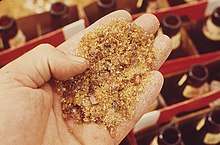
"Recyclate" is a raw material that is sent to, and processed in a waste recycling plant or materials recovery facility which will be used to form new products.[36] The material is collected in various methods and delivered to a facility where it undergoes re-manufacturing so that it can be used in the production of new materials or products. For example, plastic bottles that are collected can be re-used and made into plastic pellets, a new product.[37]
Quality of recyclate
The quality of recyclates is recognized as one of the principal challenges that needs to be addressed for the success of a long-term vision of a green economy and achieving zero waste. Recyclate quality is generally referring to how much of the raw material is made up of target material compared to the amount of non-target material and other non-recyclable material.[38] For example, steel and metal are materials with a higher recyclate quality. It's estimated that two-thirds of all new steel manufactured comes from recycled steel.[39] Only target material is likely to be recycled, so a higher amount of non-target and non-recyclable material will reduce the quantity of recycling product.[38] A high proportion of non-target and non-recyclable material can make it more difficult for re-processors to achieve "high-quality" recycling. If the recyclate is of poor quality, it is more likely to end up being down-cycled or, in more extreme cases, sent to other recovery options or landfilled.[38] For example, to facilitate the re-manufacturing of clear glass products there are tight restrictions for colored glass going into the re-melt process. Another example is the downcycling of plastic, in which products such as plastic food packaging are often downcycled into lower quality products, and do not get recycled into the same plastic food packaging.
The quality of recyclate not only supports high-quality recycling, but it can also deliver significant environmental benefits by reducing, reusing and keeping products out of landfills.[38] High-quality recycling can help support growth in the economy by maximizing the economic value of the waste material collected.[38] Higher income levels from the sale of quality recyclates can return value which can be significant to local governments, households, and businesses.[38] Pursuing high-quality recycling can also provide consumer and business confidence in the waste and resource management sector and may encourage investment in that sector.
There are many actions along the recycling supply chain that can influence and affect the material quality of recyclate.[40] It begins with the waste producers who place non-target and non-recyclable wastes in recycling collection. This can affect the quality of final recyclate streams or require further efforts to discard those materials at later stages in the recycling process.[40] The different collection systems can result in different levels of contamination. Depending on which materials are collected together, extra effort is required to sort this material back into separate streams and can significantly reduce the quality of the final product.[40] Transportation and the compaction of materials can make it more difficult to separate material back into separate waste streams. Sorting facilities are not one hundred per cent effective in separating materials, despite improvements in technology and quality recyclate which can see a loss in recyclate quality.[40] The storage of materials outside, where the product can become wet, can cause problems for re-processors. Reprocessing facilities may require further sorting steps to further reduce the amount of non-target and non-recyclable material.[40] Each action along the recycling path plays a part in the quality of recyclate.
Quality recyclate action plan (Scotland)
The Recyclate Quality Action Plan of Scotland sets out a number of proposed actions that the Scottish Government would like to take forward in order to drive up the quality of the materials being collected for recycling and sorted at materials recovery facilities before being exported or sold on to the reprocessing market.[40]
The plan's objectives are to:[41]
- Drive up the quality of recyclate
- Deliver greater transparency about the quality of recyclate
- Provide help to those contracting with materials recycling facilities to identify what is required of them
- Ensure compliance with the Waste (Scotland) regulations 2012
- Stimulate a household market for quality recyclate
- Address and reduce issues surrounding the Waste Shipment Regulations
The plan focuses on three key areas, with fourteen actions which were identified to increase the quality of materials collected, sorted and presented to the processing market in Scotland.[41]
The three areas of focus are:[40]
- Collection systems and input contamination
- Sorting facilities – material sampling and transparency
- Material quality benchmarking and standards
Recycling consumer waste
Collection
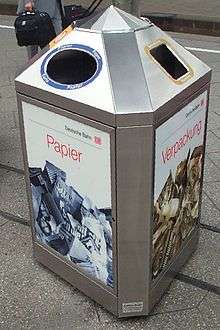
A number of different systems have been implemented to collect recyclates from the general waste stream. These systems lie along the spectrum of trade-off between public convenience and government ease and expense. The three main categories of collection are "drop-off centers", "buy-back centers", and "curbside collection".[5]
Curbside collection
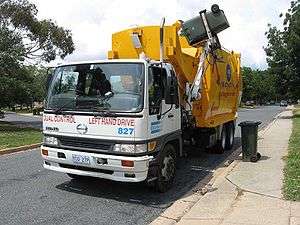
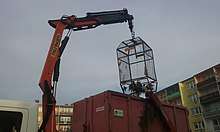
Curbside collection encompasses many subtly different systems, which differ mostly on where in the process the recyclates are sorted and cleaned. The main categories are mixed waste collection, commingled recyclables, and source separation.[5] A waste collection vehicle generally picks up the waste.
At one end of the spectrum is mixed waste collection, in which all recyclates are collected mixed in with the rest of the waste, and the desired material is then sorted out and cleaned at a central sorting facility. This results in a large amount of recyclable waste, paper especially, being too soiled to reprocess, but has advantages as well: the city need not pay for a separate collection of recyclates and no public education is needed. Any changes to which materials are recyclable is easy to accommodate as all sorting happens in a central location.[5]
In a commingled or single-stream system, all recyclables for collection are mixed but kept separate from other waste. This greatly reduces the need for post-collection cleaning but does require public education on what materials are recyclable.[5][8]
Source separation
Source separation is the other extreme, where each material is cleaned and sorted prior to collection. This method requires the least post-collection sorting and produces the purest recyclates, but incurs additional operating costs for collection of each separate material. An extensive public education program is also required, which must be successful if recyclate contamination is to be avoided.[5] In Oregon, USA, its environmental authority Oregon DEQ surveyed multi-family property managers and about half of them reported problems including contamination of recyclables due to trespassers such as transients gaining access to the collection areas.[42]
Source separation used to be the preferred method due to the high sorting costs incurred by commingled (mixed waste) collection. However, advances in sorting technology have lowered this overhead substantially. Many areas which had developed source separation programs have since switched to what is called co-mingled collection.[8]
Buy-back centers
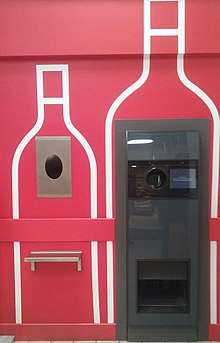
Buy-back centers differ in that the cleaned recyclates are purchased, thus providing a clear incentive for use and creating a stable supply. The post-processed material can then be sold. If this is profitable, this conserves the emission of greenhouse gases; if unprofitable, it increases the emission of greenhouse gases. Government subsidies are necessary to make buy-back centres a viable enterprise. In 1993, according to the U.S. National Waste & Recycling Association, it costs on average $50 to process a ton of material, which can be resold for $30.[5]
In the US, the value per ton of mixed recyclables was $180 in 2011, $80 in 2015, and $100 in 2017.[43]
In 2017, glass is essentially valueless, because of the low cost of sand, its major component; low oil costs thwarts plastic recycling.[43]
In 2017, Napa, California was reimbursed about 20% of its costs in recycling.[43]
Drop-off centers
Drop-off centers require the waste producer to carry the recyclates to a central location, either an installed or mobile collection station or the reprocessing plant itself. They are the easiest type of collection to establish but suffer from low and unpredictable throughput.
Distributed recycling
For some waste materials such as plastic, recent technical devices called recyclebots[44] enable a form of distributed recycling. Preliminary life-cycle analysis (LCA) indicates that such distributed recycling of HDPE to make filament of 3D printers in rural regions is energetically favorable to either using virgin resin or conventional recycling processes because of reductions in transportation energy.[45][46]
Sorting
Once commingled recyclates are collected and delivered to a materials recovery facility, the different types of materials must be sorted. This is done in a series of stages, many of which involve automated processes such that a truckload of material can be fully sorted in less than an hour.[8] Some plants can now sort the materials automatically, known as single-stream recycling. Automatic sorting may be aided by robotics and machine-learning.[47][48] In plants, a variety of materials is sorted such as paper, different types of plastics, glass, metals, food scraps, and most types of batteries.[49] A 30 percent increase in recycling rates has been seen in the areas where these plants exist.[50] In the United States, there are over 300 materials recovery facilities.[51]
Initially, the commingled recyclates are removed from the collection vehicle and placed on a conveyor belt spread out in a single layer. Large pieces of corrugated fiberboard and plastic bags are removed by hand at this stage, as they can cause later machinery to jam.[8]
Next, automated machinery such as disk screens and air classifiers separate the recyclates by weight, splitting lighter paper and plastic from heavier glass and metal. Cardboard is removed from the mixed paper and the most common types of plastic, PET (#1) and HDPE (#2), are collected. This separation is usually done by hand but has become automated in some sorting centers: a spectroscopic scanner is used to differentiate between different types of paper and plastic based on the absorbed wavelengths, and subsequently divert each material into the proper collection channel.[8]
Strong magnets are used to separate out ferrous metals, such as iron, steel, and tin cans. Non-ferrous metals are ejected by magnetic eddy currents in which a rotating magnetic field induces an electric current around the aluminum cans, which in turn creates a magnetic eddy current inside the cans. This magnetic eddy current is repulsed by a large magnetic field, and the cans are ejected from the rest of the recyclate stream.[8]

Finally, glass is sorted according to its color: brown, amber, green, or clear. It may either be sorted by hand,[8] or via an automated machine that uses colored filters to detect different colors. Glass fragments smaller than 10 millimetres (0.39 in) across cannot be sorted automatically, and are mixed together as "glass fines".[52]
This process of recycling as well as reusing the recycled material has proven advantageous because it reduces amount of waste sent to landfills, conserves natural resources, saves energy, reduces greenhouse gas emissions, and helps create new jobs. Recycled materials can also be converted into new products that can be consumed again, such as paper, plastic, and glass.[53]
The City and County of San Francisco's Department of the Environment is attempting to achieve a citywide goal of generating zero waste by 2020.[54] San Francisco's refuse hauler, Recology, operates an effective recyclables sorting facility which helped the city reach a record-breaking diversion rate of 80%.[55]
Recycling industrial waste
Although many government programs are concentrated on recycling at home, 64% of waste in the United Kingdom is generated by industry.[56] The focus of many recycling programs done by industry is the cost–effectiveness of recycling. The ubiquitous nature of cardboard packaging makes cardboard a commonly recycled waste product by companies that deal heavily in packaged goods, like retail stores, warehouses, and distributors of goods. Other industries deal in niche or specialized products, depending on the nature of the waste materials that are present.
The glass, lumber, wood pulp and paper manufacturers all deal directly in commonly recycled materials; however, old rubber tires may be collected and recycled by independent tire dealers for a profit.
Levels of metals recycling are generally low. In 2010, the International Resource Panel, hosted by the United Nations Environment Programme (UNEP) published reports on metal stocks that exist within society[57] and their recycling rates.[57] The Panel reported that the increase in the use of metals during the 20th and into the 21st century has led to a substantial shift in metal stocks from below ground to use in applications within society above ground. For example, the in-use stock of copper in the USA grew from 73 to 238 kg per capita between 1932 and 1999.
The report authors observed that, as metals are inherently recyclable, the metal stocks in society can serve as huge mines above ground (the term "urban mining" has been coined with this idea in mind[58]). However, they found that the recycling rates of many metals are very low. The report warned that the recycling rates of some rare metals used in applications such as mobile phones, battery packs for hybrid cars and fuel cells, are so low that unless future end-of-life recycling rates are dramatically stepped up these critical metals will become unavailable for use in modern technology.
The military recycles some metals. The U.S. Navy's Ship Disposal Program uses ship breaking to reclaim the steel of old vessels. Ships may also be sunk to create an artificial reef. Uranium is a very dense metal that has qualities superior to lead and titanium for many military and industrial uses. The uranium left over from processing it into nuclear weapons and fuel for nuclear reactors is called depleted uranium, and is used by all branches of the U.S. military for the development of such things as armour-piercing shells and shielding.
The construction industry may recycle concrete and old road surface pavement, selling their waste materials for profit.
Some industries, like the renewable energy industry and solar photovoltaic technology, in particular, are being proactive in setting up recycling policies even before there is considerable volume to their waste streams, anticipating future demand during their rapid growth.[59]
Recycling of plastics is more difficult, as most programs are not able to reach the necessary level of quality. Recycling of PVC often results in downcycling of the material, which means only products of lower quality standard can be made with the recycled material. A new approach which allows an equal level of quality is the Vinyloop process. It was used after the London Olympics 2012 to fulfill the PVC Policy.[60]
E-waste recycling

E-waste is a growing problem, accounting for 20–50 million metric tons of global waste per year according to the EPA. It is also the fastest growing waste stream in the EU.[23] Many recyclers do not recycle e-waste responsibly. After the cargo barge Khian Sea dumped 14,000 metric tons of toxic ash in Haiti, the Basel Convention was formed to stem the flow of hazardous substances into poorer countries. They created the e-Stewards certification to ensure that recyclers are held to the highest standards for environmental responsibility and to help consumers identify responsible recyclers. This works alongside other prominent legislation, such as the Waste Electrical and Electronic Equipment Directive of the EU the United States National Computer Recycling Act, to prevent poisonous chemicals from entering waterways and the atmosphere.
In the recycling process, television sets, monitors, cell phones, and computers are typically tested for reuse and repaired. If broken, they may be disassembled for parts still having high value if labor is cheap enough. Other e-waste is shredded to pieces roughly 10 centimetres (3.9 in) in size, and manually checked to separate out toxic batteries and capacitors which contain poisonous metals. The remaining pieces are further shredded to 10 millimetres (0.39 in) particles and passed under a magnet to remove ferrous metals. An eddy current ejects non-ferrous metals, which are sorted by density either by a centrifuge or vibrating plates. Precious metals can be dissolved in acid, sorted, and smelted into ingots. The remaining glass and plastic fractions are separated by density and sold to re-processors. Television sets and monitors must be manually disassembled to remove lead from CRTs or the mercury backlight from LCDs.[61][62][63]
Plastic recycling
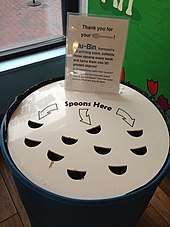
Plastic recycling is the process of recovering scrap or waste plastic and reprocessing the material into useful products, sometimes completely different in form from their original state. For instance, this could mean melting down soft drink bottles and then casting them as plastic chairs and tables.[64] For some types of plastic, the same piece of plastic can only be recycled about 2–3 times before its quality decreases to the point where it can no longer be used.[6]
Physical recycling
Some plastics are remelted to form new plastic objects; for example, PET water bottles can be converted into polyester destined for clothing. A disadvantage of this type of recycling is that the molecular weight of the polymer can change further and the levels of unwanted substances in the plastic can increase with each remelt.
A commercial-built recycling facility was sent to the International Space Station in late 2019. The facility will take in plastic waste and unneeded plastic parts and physically convert them into spools of feedstock for the space station additive manufacturing facility used for in-space 3D printing.[65]
Chemical recycling
For some polymers, it is possible to convert them back into monomers, for example, PET can be treated with an alcohol and a catalyst to form a dialkyl terephthalate. The terephthalate diester can be used with ethylene glycol to form a new polyester polymer, thus making it possible to use the pure polymer again. In 2019, Eastman Chemical Company announced initiatives of methanolysis and syngas designed to handle a greater variety of used material.[66]
Waste plastic pyrolysis to fuel oil
Another process involves the conversion of assorted polymers into petroleum by a much less precise thermal depolymerization process. Such a process would be able to accept almost any polymer or mix of polymers, including thermoset materials such as vulcanized rubber tires and the biopolymers in feathers and other agricultural waste. Like natural petroleum, the chemicals produced can be used as fuels or as feedstock. A RESEM Technology[67] plant of this type in Carthage, Missouri, US, uses turkey waste as input material. Gasification is a similar process but is not technically recycling since polymers are not likely to become the result. Plastic Pyrolysis can convert petroleum based waste streams such as plastics into quality fuels, carbons. Given below is the list of suitable plastic raw materials for pyrolysis:
Recycling loops
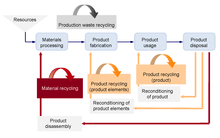
The (ideal) recycling process can be differentiated into three loops, one for manufacture (production-waste recycling) and two for disposal of the product (product and material recycling).[68]
The product's manufacturing phase, which consists of material processing and fabrication, forms the production-waste recycling loop. Industrial waste materials are fed back into, and reused in, the same production process.
The product's disposal process requires two recycling loops: product recycling and material recycling.[68] The product or product parts are reused in the product recycling phase. This happens in one of two ways: the product is used retaining the product functionality ("reuse") or the product continues to be used but with altered functionality ("further use").[68] The product design is unmodified, or only slightly modified, in both scenarios.
Product disassembly requires material recycling where product materials are recovered and recycled. Ideally, the materials are processed so they can flow back into the production process.[68]
Recycling codes
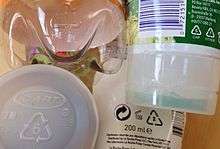
In order to meet recyclers' needs while providing manufacturers a consistent, uniform system, a coding system was developed. The recycling code for plastics was introduced in 1988 by the plastics industry through the Society of the Plastics Industry.[69] Because municipal recycling programs traditionally have targeted packaging—primarily bottles and containers—the resin coding system offered a means of identifying the resin content of bottles and containers commonly found in the residential waste stream.[70]
Plastic products are printed with numbers 1–7 depending on the type of resin. Type 1 (polyethylene terephthalate) is commonly found in soft drink and water bottles. Type 2 (high-density polyethylene) is found in most hard plastics such as milk jugs, laundry detergent bottles, and some dishware. Type 3 (polyvinyl chloride) includes items such as shampoo bottles, shower curtains, hula hoops, credit cards, wire jacketing, medical equipment, siding, and piping. Type 4 (low-density polyethylene) is found in shopping bags, squeezable bottles, tote bags, clothing, furniture, and carpet. Type 5 is polypropylene and makes up syrup bottles, straws, Tupperware, and some automotive parts. Type 6 is polystyrene and makes up meat trays, egg cartons, clamshell containers, and compact disc cases. Type 7 includes all other plastics such as bulletproof materials, 3- and 5-gallon water bottles, cell phone and tablet frames, safety goggles and sunglasses.[71] Having a recycling code or the chasing arrows logo on a material is not an automatic indicator that a material is recyclable but rather an explanation of what the material is. Types 1 and 2 are the most commonly recycled.
Cost–benefit analysis
| Material | Energy savings vs. new production | Air pollution savings vs. new production |
|---|---|---|
| Aluminium | 95%[5][19] | 95%[5][73] |
| Cardboard | 24% | — |
| Glass | 5–30% | 20% |
| Paper | 40%[19] | 73%[74] |
| Plastics | 70%[19] | — |
| Steel | 60%[8] | — |
There is some debate over whether recycling is economically efficient. According to a Natural Resources Defense Council study, waste collection and landfill disposal creates less than one job per 1,000 tons of waste material managed; in contrast, the collection, processing, and manufacturing of recycled materials creates 6–13 or more jobs per 1,000 tons.[75] However, the cost effectiveness of creating the additional jobs remains unproven. According to the U.S. Recycling Economic Informational Study, there are over 50,000 recycling establishments that have created over a million jobs in the US.[76]
Two years after New York City declared that implementing recycling programs would be "a drain on the city", New York City leaders realized that an efficient recycling system could save the city over $20 million.[77] Municipalities often see fiscal benefits from implementing recycling programs, largely due to the reduced landfill costs.[78] A study conducted by the Technical University of Denmark according to the Economist found that in 83 percent of cases, recycling is the most efficient method to dispose of household waste.[8][19] However, a 2004 assessment by the Danish Environmental Assessment Institute concluded that incineration was the most effective method for disposing of drink containers, even aluminium ones.[79]
Fiscal efficiency is separate from economic efficiency. Economic analysis of recycling does not include what economists call externalities, which are unpriced costs and benefits that accrue to individuals outside of private transactions. Examples include: decreased air pollution and greenhouse gases from incineration, reduced hazardous waste leaching from landfills, reduced energy consumption, and reduced waste and resource consumption, which leads to a reduction in environmentally damaging mining and timber activity. About 4,000 minerals are known, of which only a few hundred are relatively common.[80] Known reserves of phosphorus will be exhausted within the next 100 years at current rates of usage.[81][82] Without mechanisms such as taxes or subsidies to internalize externalities, businesses may ignore them despite the costs imposed on society. To make such nonfiscal benefits economically relevant, advocates have pushed for legislative action to increase the demand for recycled materials.[5] The United States Environmental Protection Agency (EPA) has concluded in favor of recycling, saying that recycling efforts reduced the country's carbon emissions by a net 49 million metric tonnes in 2005.[8] In the United Kingdom, the Waste and Resources Action Programme stated that Great Britain's recycling efforts reduce CO2 emissions by 10–15 million tonnes a year.[8] Recycling is more efficient in densely populated areas, as there are economies of scale involved.[5]

Certain requirements must be met for recycling to be economically feasible and environmentally effective. These include an adequate source of recyclates, a system to extract those recyclates from the waste stream, a nearby factory capable of reprocessing the recyclates, and a potential demand for the recycled products. These last two requirements are often overlooked—without both an industrial market for production using the collected materials and a consumer market for the manufactured goods, recycling is incomplete and in fact only "collection".[5]
Free-market economist Julian Simon remarked "There are three ways society can organize waste disposal: (a) commanding, (b) guiding by tax and subsidy, and (c) leaving it to the individual and the market". These principles appear to divide economic thinkers today.[83]
Frank Ackerman favours a high level of government intervention to provide recycling services. He believes that recycling's benefit cannot be effectively quantified by traditional laissez-faire economics. Allen Hershkowitz supports intervention, saying that it is a public service equal to education and policing. He argues that manufacturers should shoulder more of the burden of waste disposal.[83]
Paul Calcott and Margaret Walls advocate the second option. A deposit refund scheme and a small refuse charge would encourage recycling but not at the expense of fly-tipping. Thomas C. Kinnaman concludes that a landfill tax would force consumers, companies and councils to recycle more.[83]
Most free-market thinkers detest subsidy and intervention because they waste resources. Terry Anderson and Donald Leal think that all recycling programmes should be privately operated, and therefore would only operate if the money saved by recycling exceeds its costs. Daniel K. Benjamin argues that it wastes people's resources and lowers the wealth of a population.[83]
The National Waste & Recycling Association (NWRA) then again reported in May 2015, that recycling and waste made a $6.7 billion economic impact in Ohio, U.S., and employed 14,000 people.[84]
Trade in recyclates
Certain countries trade in unprocessed recyclates. Some have complained that the ultimate fate of recyclates sold to another country is unknown and they may end up in landfills instead of being reprocessed. According to one report, in America, 50–80 percent of computers destined for recycling are actually not recycled.[85][86] There are reports of illegal-waste imports to China being dismantled and recycled solely for monetary gain, without consideration for workers' health or environmental damage. Although the Chinese government has banned these practices, it has not been able to eradicate them.[87] In 2008, the prices of recyclable waste plummeted before rebounding in 2009. Cardboard averaged about £53/tonne from 2004 to 2008, dropped to £19/tonne, and then went up to £59/tonne in May 2009. PET plastic averaged about £156/tonne, dropped to £75/tonne and then moved up to £195/tonne in May 2009.[88]
Certain regions have difficulty using or exporting as much of a material as they recycle. This problem is most prevalent with glass: both Britain and the U.S. import large quantities of wine bottled in green glass. Though much of this glass is sent to be recycled, outside the American Midwest there is not enough wine production to use all of the reprocessed material. The extra must be downcycled into building materials or re-inserted into the regular waste stream.[5][8]
Similarly, the northwestern United States has difficulty finding markets for recycled newspaper, given the large number of pulp mills in the region as well as the proximity to Asian markets. In other areas of the U.S., however, demand for used newsprint has seen wide fluctuation.[5]
In some U.S. states, a program called RecycleBank pays people to recycle, receiving money from local municipalities for the reduction in landfill space which must be purchased. It uses a single stream process in which all material is automatically sorted.[89]
Criticisms and responses
Critics dispute the net economic and environmental benefits of recycling over its costs, and suggest that proponents of recycling often make matters worse and suffer from confirmation bias. Specifically, critics argue that the costs and energy used in collection and transportation detract from (and outweigh) the costs and energy saved in the production process; also that the jobs produced by the recycling industry can be a poor trade for the jobs lost in logging, mining, and other industries associated with production; and that materials such as paper pulp can only be recycled a few times before material degradation prevents further recycling.[90]
Much of the difficulty inherent in recycling comes from the fact that most products are not designed with recycling in mind. The concept of sustainable design aims to solve this problem, and was laid out in the book Cradle to Cradle: Remaking the Way We Make Things by architect William McDonough and chemist Michael Braungart.[91] They suggest that every product (and all packaging it requires) should have a complete "closed-loop" cycle mapped out for each component—a way in which every component will either return to the natural ecosystem through biodegradation or be recycled indefinitely.[8][92]
Complete recycling is impossible from a practical standpoint. In summary, substitution and recycling strategies only delay the depletion of non-renewable stocks and therefore may buy time in the transition to true or strong sustainability, which ultimately is only guaranteed in an economy based on renewable resources.[93]:21
— M. H. Huesemann, 2003
While recycling diverts waste from entering directly into landfill sites, current recycling misses the dispersive components. These critics believe that complete recycling is impracticable as highly dispersed wastes become so diluted that the energy needed for their recovery becomes increasingly excessive.
As with environmental economics, care must be taken to ensure a complete view of the costs and benefits involved. For example, paperboard packaging for food products is more easily recycled than most plastic, but is heavier to ship and may result in more waste from spoilage.[94]
Energy and material flows
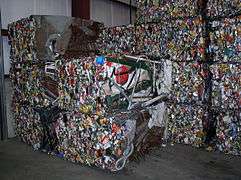
The amount of energy saved through recycling depends upon the material being recycled and the type of energy accounting that is used. Correct accounting for this saved energy can be accomplished with life-cycle analysis using real energy values, and in addition, exergy, which is a measure of how much useful energy can be used. In general, it takes far less energy to produce a unit mass of recycled materials than it does to make the same mass of virgin materials.[95][96][97]
Some scholars use emergy (spelled with an m) analysis, for example, budgets for the amount of energy of one kind (exergy) that is required to make or transform things into another kind of product or service. Emergy calculations take into account economics which can alter pure physics-based results. Using emergy life-cycle analysis researchers have concluded that materials with large refining costs have the greatest potential for high recycle benefits. Moreover, the highest emergy efficiency accrues from systems geared toward material recycling, where materials are engineered to recycle back into their original form and purpose, followed by adaptive reuse systems where the materials are recycled into a different kind of product, and then by-product reuse systems where parts of the products are used to make an entirely different product.[98]
The Energy Information Administration (EIA) states on its website that "a paper mill uses 40 percent less energy to make paper from recycled paper than it does to make paper from fresh lumber."[99] Some critics argue that it takes more energy to produce recycled products than it does to dispose of them in traditional landfill methods, since the curbside collection of recyclables often requires a second waste truck. However, recycling proponents point out that a second timber or logging truck is eliminated when paper is collected for recycling, so the net energy consumption is the same. An emergy life-cycle analysis on recycling revealed that fly ash, aluminum, recycled concrete aggregate, recycled plastic, and steel yield higher efficiency ratios, whereas the recycling of lumber generates the lowest recycle benefit ratio. Hence, the specific nature of the recycling process, the methods used to analyse the process, and the products involved affect the energy savings budgets.[98]
It is difficult to determine the amount of energy consumed or produced in waste disposal processes in broader ecological terms, where causal relations dissipate into complex networks of material and energy flow. For example, "cities do not follow all the strategies of ecosystem development. Biogeochemical paths become fairly straight relative to wild ecosystems, with very reduced recycling, resulting in large flows of waste and low total energy efficiencies. By contrast, in wild ecosystems, one population's wastes are another population's resources, and succession results in efficient exploitation of available resources. However, even modernized cities may still be in the earliest stages of a succession that may take centuries or millennia to complete."[100]:720 How much energy is used in recycling also depends on the type of material being recycled and the process used to do so. Aluminium is generally agreed to use far less energy when recycled rather than being produced from scratch. The EPA states that "recycling aluminum cans, for example, saves 95 percent of the energy required to make the same amount of aluminum from its virgin source, bauxite."[101][102] In 2009, more than half of all aluminium cans produced came from recycled aluminium.[103] Similarly, it has been estimated that new steel produced with recycled cans reduces greenhouse gas emissions by 75%.[104]
Every year, millions of tons of materials are being exploited from the earth's crust, and processed into consumer and capital goods. After decades to centuries, most of these materials are "lost". With the exception of some pieces of art or religious relics, they are no longer engaged in the consumption process. Where are they? Recycling is only an intermediate solution for such materials, although it does prolong the residence time in the anthroposphere. For thermodynamic reasons, however, recycling cannot prevent the final need for an ultimate sink.[105]:1
— P. H. Brunner
Economist Steven Landsburg has suggested that the sole benefit of reducing landfill space is trumped by the energy needed and resulting pollution from the recycling process.[106] Others, however, have calculated through life-cycle assessment that producing recycled paper uses less energy and water than harvesting, pulping, processing, and transporting virgin trees.[107] When less recycled paper is used, additional energy is needed to create and maintain farmed forests until these forests are as self-sustainable as virgin forests.
Other studies have shown that recycling in itself is inefficient to perform the "decoupling" of economic development from the depletion of non-renewable raw materials that is necessary for sustainable development.[108] The international transportation or recycle material flows through "... different trade networks of the three countries result in different flows, decay rates, and potential recycling returns".[109]:1 As global consumption of a natural resources grows, their depletion is inevitable. The best recycling can do is to delay; complete closure of material loops to achieve 100 percent recycling of nonrenewables is impossible as micro-trace materials dissipate into the environment causing severe damage to the planet's ecosystems.[110][111][112] Historically, this was identified as the metabolic rift by Karl Marx, who identified the unequal exchange rate between energy and nutrients flowing from rural areas to feed urban cities that create effluent wastes degrading the planet's ecological capital, such as loss in soil nutrient production.[113][114] Energy conservation also leads to what is known as Jevon's paradox, where improvements in energy efficiency lowers the cost of production and leads to a rebound effect where rates of consumption and economic growth increases.[112][115]

Costs
The amount of money actually saved through recycling depends on the efficiency of the recycling program used to do it. The Institute for Local Self-Reliance argues that the cost of recycling depends on various factors, such as landfill fees and the amount of disposal that the community recycles. It states that communities begin to save money when they treat recycling as a replacement for their traditional waste system rather than an add-on to it and by "redesigning their collection schedules and/or trucks".[116]
In some cases, the cost of recyclable materials also exceeds the cost of raw materials. Virgin plastic resin costs 40 percent less than recycled resin.[117] Additionally, a United States Environmental Protection Agency (EPA) study that tracked the price of clear glass from 15 July to 2 August 1991, found that the average cost per ton ranged from $40 to $60[118] while a USGS report shows that the cost per ton of raw silica sand from years 1993 to 1997 fell between $17.33 and $18.10.[119]
Comparing the market cost of recyclable material with the cost of new raw materials ignores economic externalities—the costs that are currently not counted by the market. Creating a new piece of plastic, for instance, may cause more pollution and be less sustainable than recycling a similar piece of plastic, but these factors will not be counted in market cost. A life cycle assessment can be used to determine the levels of externalities and decide whether the recycling may be worthwhile despite unfavorable market costs. Alternatively, legal means (such as a carbon tax) can be used to bring externalities into the market, so that the market cost of the material becomes close to the true cost.
Working conditions
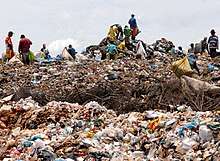
The recycling of waste electrical and electronic equipment can create a significant amount of pollution. This problem is specifically occurrent in India and China. Informal recycling in an underground economy of these countries has generated an environmental and health disaster. High levels of lead (Pb), polybrominated diphenylethers (PBDEs), polychlorinated dioxins and furans, as well as polybrominated dioxins and furans (PCDD/Fs and PBDD/Fs), concentrated in the air, bottom ash, dust, soil, water, and sediments in areas surrounding recycling sites.[120] These materials can make work sites harmful to the workers themselves and the surrounding environment.
Environmental impact
Economist Steven Landsburg, author of a paper entitled "Why I Am Not an Environmentalist",[121] claimed that paper recycling actually reduces tree populations. He argues that because paper companies have incentives to replenish their forests, large demands for paper lead to large forests while reduced demand for paper leads to fewer "farmed" forests.[122]

When foresting companies cut down trees, more are planted in their place; however, such "farmed" forests are inferior to natural forests in several ways. Farmed forests are not able to fix the soil as quickly as natural forests. This can cause widespread soil erosion and often requiring large amounts of fertilizer to maintain the soil, while containing little tree and wild-life biodiversity compared to virgin forests.[123] Also, the new trees planted are not as big as the trees that were cut down, and the argument that there will be "more trees" is not compelling to forestry advocates when they are counting saplings.
In particular, wood from tropical rainforests is rarely harvested for paper because of their heterogeneity.[124] According to the United Nations Framework Convention on Climate Change secretariat, the overwhelming direct cause of deforestation is subsistence farming (48% of deforestation) and commercial agriculture (32%), which is linked to food, not paper production.[125]
The reduction of greenhouse gas emission reduction also benefits from the development of the recycling industry. In Kitakyushu, the only green growth model city in Asia selected by OECD, recycling industries are strongly promoted and financially supported as part of the Eco-town program in Japan. Given the industrial sector in Kitakyushu accounts for more than 60% energy consumption of the city, the development of recycling industry results in substantial energy reduction due to the economies of scale effects; the concentration of CO is, thus, found to decline accordingly.[126]
Other non-conventional methods of material recycling, like Waste-to-Energy (WTE) systems, have garnered increased attention in the recent past due to the polarizing nature of their emissions. While viewed as a sustainable method of capturing energy from material waste feedstocks by many, others have cited numerous explanations for why the technology has not been scaled globally.[127]
Possible income loss and social costs
In some countries, recycling is performed by the entrepreneurial poor such as the karung guni, zabbaleen, the rag-and-bone man, waste picker, and junk man. With the creation of large recycling organizations that may be profitable, either by law or economies of scale,[128][129] the poor are more likely to be driven out of the recycling and the remanufacturing job market. To compensate for this loss of income, a society may need to create additional forms of societal programs to help support the poor.[130] Like the parable of the broken window, there is a net loss to the poor and possibly the whole of a society to make recycling artificially profitable, e.g. through the law. However, in Brazil and Argentina, waste pickers/informal recyclers work alongside the authorities, in fully or semi-funded cooperatives, allowing informal recycling to be legitimized as a paid public sector job.[131]
Because the social support of a country is likely to be less than the loss of income to the poor undertaking recycling, there is a greater chance the poor will come in conflict with the large recycling organizations.[132][133] This means fewer people can decide if certain waste is more economically reusable in its current form rather than being reprocessed. Contrasted to the recycling poor, the efficiency of their recycling may actually be higher for some materials because individuals have greater control over what is considered "waste".[130]
One labor-intensive underused waste is electronic and computer waste. Because this waste may still be functional and wanted mostly by those on lower incomes, who may sell or use it at a greater efficiency than large recyclers.
Some recycling advocates believe that laissez-faire individual-based recycling does not cover all of society's recycling needs. Thus, it does not negate the need for an organized recycling program.[130] Local government can consider the activities of the recycling poor as contributing to the ruining of property.
Public participation rates
.jpg)
Changes that have been demonstrated to increase recycling rates include:
- Single-stream recycling
- Pay as you throw fees for trash
"Between 1960 and 2000, the world production of plastic resins increased 25 times its original amount, while recovery of the material remained below 5 percent."[134]:131 Many studies have addressed recycling behaviour and strategies to encourage community involvement in recycling programs. It has been argued[135] that recycling behavior is not natural because it requires a focus and appreciation for long-term planning, whereas humans have evolved to be sensitive to short-term survival goals; and that to overcome this innate predisposition, the best solution would be to use social pressure to compel participation in recycling programs. However, recent studies have concluded that social pressure will not work in this context.[136] One reason for this is that social pressure functions well in small group sizes of 50 to 150 individuals (common to nomadic hunter–gatherer peoples) but not in communities numbering in the millions, as we see today. Another reason is that individual recycling does not take place in the public view.
Following the increasing popularity of recycling collection being sent to the same landfills as trash, some people kept on putting recyclables on the recyclables bin.[137] In Baltimore, the government kept collecting glass separately for seven years even though it did not recycle it.[138]
Recycling in art

Art objects are more and more often made from recycled material.
In a study done by social psychologist Shawn Burn,[139] it was found that personal contact with individuals within a neighborhood is the most effective way to increase recycling within a community. In his study, he had 10 block leaders talk to their neighbors and persuade them to recycle. A comparison group was sent fliers promoting recycling. It was found that the neighbors that were personally contacted by their block leaders recycled much more than the group without personal contact. As a result of this study, Shawn Burn believes that personal contact within a small group of people is an important factor in encouraging recycling. Another study done by Stuart Oskamp[140] examines the effect of neighbors and friends on recycling. It was found in his studies that people who had friends and neighbors that recycled were much more likely to also recycle than those who didn't have friends and neighbors that recycled.
Many schools have created recycling awareness clubs in order to give young students an insight on recycling. These schools believe that the clubs actually encourage students to not only recycle at school but at home as well.
See also
References
- Villalba, G., Segarra, M., Fernandez, A. I., Chimenos, J. M., & Espiell, F. (2002). A proposal for quantifying the recyclability of materials. Resources, Conservation, and Recycling, 37.
- J. Lienig, H. Bruemmer (2017). "Recycling Requirements and Design for Environmental Compliance". Fundamentals of Electronic Systems Design. Springer. pp. 193–218. doi:10.1007/978-3-319-55840-0_7. ISBN 978-3-319-55839-4.
- European Commission (2014). "EU Waste Legislation". Archived from the original on 12 March 2014.
- Geissdoerfer, Martin; Savaget, Paulo; Bocken, Nancy M.P.; Hultink, Erik Jan (2017). "The Circular Economy – A new sustainability paradigm?". Journal of Cleaner Production. 143: 757–768. doi:10.1016/j.jclepro.2016.12.048. ISSN 0959-6526.
- The League of Women Voters (1993). The Garbage Primer. New York: Lyons & Burford. pp. 35–72. ISBN 978-1-55821-250-3.
- "7 Things You Didn’t Know About Plastic (and Recycling)" National Geographic. Retrieved 26 July 2019.
- Black Dog Publishing (2006). Recycle : a source book. London, UK: Black Dog Publishing. ISBN 978-1-904772-36-1.
- "The truth about recycling". The Economist. 7 June 2007.
- Cleveland, Cutler J.; Morris, Christopher G. (15 November 2013). Handbook of Energy: Chronologies, Top Ten Lists, and Word Clouds. Elsevier. p. 461. ISBN 978-0-12-417019-3.
- Dadd-Redalia, Debra (1 January 1994). Sustaining the earth: choosing consumer products that are safe for you, your family, and the earth. New York: Hearst Books. p. 103. ISBN 978-0-688-12335-2. OCLC 29702410.
- Nongpluh, Yoofisaca Syngkon. Know all about : reduce, reuse, recycle. Noronha, Guy C.,, Energy and Resources Institute. New Delhi. ISBN 978-1-4619-4003-6. OCLC 858862026.
- Carl A. Zimring (2005). Cash for Your Trash: Scrap Recycling in America. New Brunswick, NJ: Rutgers University Press. ISBN 978-0-8135-4694-0.
- "sd_shire" (PDF). Archived from the original (PDF) on 14 October 2012. Retrieved 27 October 2012.
- Rethinking economic incentives for separate collection. Zero Waste Europe & Reloop Platform, 2017
- "Report: "On the Making of Silk Purses from Sows' Ears," 1921: Exhibits: Institute Archives & Special Collections: MIT". mit.edu. Archived from the original on 3 June 2016. Retrieved 7 July 2016.
- Public Broadcasting System (2007). "The War Episode 2: Rationing and Recycling". Retrieved 7 July 2016.
- Out of the Garbage-Pail into the Fire: fuel bricks now added to the list of things salvaged by science from the nation's waste, Popular Science monthly, February 1919, page 50-51, Scanned by Google Books: https://books.google.com/books?id=7igDAAAAMBAJ&pg=PA50
- "Recycling through the ages: 1970s". Plastic Expert. Plastic Expert. 30 July 2014. Retrieved 7 March 2015.
- "The price of virtue". The Economist. 7 June 2007.
- "CRC History – Computer Recycling Center". www.crc.org. Retrieved 29 July 2015.
- "About us – Swico Recycling". www.swicorecycling.ch. Retrieved 29 July 2015.
- "Where does e-waste end up?". www.greenpeace.org/. Greenpeace. 24 February 2009. Retrieved 29 July 2015.
- Kinver, Mark (3 July 2007). "Mechanics of e-waste recycling". BBC. Retrieved 29 July 2015.
- "Bulgaria opens largest WEEE recycling factory in Eastern Europe". www.ask-eu.com. WtERT Germany GmbH. 12 July 2010. Retrieved 29 July 2015.
- "EnvironCom opens largest WEEE recycling facility / waste & recycling news". www.greenwisebusiness.co.uk. The Sixty Mile Publishing Company. 4 March 2010. Archived from the original on 15 May 2016. Retrieved 29 July 2015.
- Goodman, Peter S. (11 January 2012). "Where Gadgets Go To Die: E-Waste Recycler Opens New Plant in Las Vegas". Huffington Post. Retrieved 29 July 2015.
- Moses, Asher (19 November 2008). "New plant tackles our electronic leftovers – BizTech – Technology – smh.com.au". www.smh.com.au. Retrieved 29 July 2015.
- European Commission, Recycling Archived 3 February 2014 at the Wayback Machine.
- Recycling rates in Europe, European Environment Agency.
- Recycling of municipal waste, European Environment Agency, 30 November 2017. (Dutch)
- Germany’s recycling rate continues to lead Europe, Resource Recycling, 7 February 2017. (Dutch)
- Hook, Leslie; Reed, John (24 October 2018). "Why the world's recycling system stopped working". Financial Times. Archived from the original on 25 October 2018. Retrieved 25 October 2018.
- "A Beverage Container Deposit Law for Hawaii". www.opala.org. City & County of Honolulu, Department of Environmental Services. October 2002. Retrieved 31 July 2015.
- European Council. "The Producer Responsibility Principle of the WEEE Directive" (PDF). Retrieved 7 July 2016.
- "Regulatory Policy Center — Property Matters — James V. DeLong". Archived from the original on 14 April 2008. Retrieved 28 February 2008.
- Web-Dictionary.com (2013). "Recyclate". Archived from the original on 7 April 2014.
- Freudenrich, C. (2014) (14 December 2007). "How Plastics Work". Retrieved 7 July 2016.
- DEFRA (2013). "Quality Action Plan Proposals to Promote High Quality Recycling of Dry Recyclates" (PDF).
- "How to Recycle Tin or Steel Cans" Earth911.com. Retrieved 26 July 2019.
- The Scottish Government (2012) (5 October 2012). "Recylate Quality Action Plan – Consultation Paper".
- The Highland Council (2013). "Report by Director of Transport, Environmental and Community Services" (PDF). Archived from the original (PDF) on 7 April 2014.
- "The State of Multi-Tenant Recycling in Oregon" (PDF). April 2018.
- Singer, Paul (21 April 2017). "Recycling market in a heap of trouble". USA Today. Melbourne, Florida. pp. 1B, 2B. Retrieved 21 April 2017.
- Baechler, Christian; DeVuono, Matthew; Pearce, Joshua M. (2013). "Distributed Recycling of Waste Polymer into RepRap Feedstock". Rapid Prototyping Journal. 19 (2): 118–125. doi:10.1108/13552541311302978.
- M. Kreiger, G. C. Anzalone, M. L. Mulder, A. Glover and J. M Pearce (2013). Distributed Recycling of Post-Consumer Plastic Waste in Rural Areas. MRS Online Proceedings Library, 1492, mrsf12-1492-g04-06 doi:10.1557/opl.2013.258. open access
- Kreiger, M.A.; Mulder, M.L.; Glover, A.G.; Pearce, J. M. (2014). "Life Cycle Analysis of Distributed Recycling of Post-consumer High Density Polyethylene for 3-D Printing Filament". Journal of Cleaner Production. 70: 90–96. doi:10.1016/j.jclepro.2014.02.009.
- "How recycling robots have spread across North America". Resource Recycling News. 7 May 2019. Retrieved 29 August 2019.
- "AMP Robotics announces largest deployment of AI-guided recycling robots". The Robot Report. 27 June 2019. Retrieved 29 August 2019.
- None, None (10 August 2015). "Common Recyclable Materials" (PDF). United States Environmental Protection Agency. Retrieved 2 February 2013.
- ScienceDaily. (2007). Recycling Without Sorting Engineers Create Recycling Plant That Removes The Need To Sort Archived 31 August 2008 at the Wayback Machine.
- "Sortation by the numbers". Resource Recycling News. 1 October 2018. Retrieved 29 August 2019.
- None, None. "What Happens to My Recycling?". 1coast.com.au. Archived from the original on 11 August 2014. Retrieved 21 July 2014.
- "Puzzled About Recycling's Value? Look Beyond the Bin" (PDF). United States Environmental Protection Agency. January 1998. Archived from the original (PDF) on 16 June 2015. Retrieved 31 July 2015.
- No Author, No Author. "Best Recycling Programs in the US & Around the World". cmfg.com. Retrieved 1 February 2013.
- "Mayor Lee Announces San Francisco Reaches 80 Percent Landfill Waste Diversion, Leads All Cities in North America | sfenvironment.org – Our Home. Our City. Our Planet". sfenvironment.org. 5 October 2012. Retrieved 9 June 2014.
- "UK statistics on waste – 2010 to 2012" (PDF). UK Government. UK Government. 25 September 2014. p. 2 and 6. Archived from the original (PDF) on 3 December 2017. Retrieved 3 December 2017.
- "Publications – International Resource Panel". unep.org. Archived from the original on 11 November 2012. Retrieved 7 July 2016.
- "How Urban Mining Works". Archived from the original on 11 July 2010. Retrieved 9 August 2013.
- McDonald, N. C.; Pearce, J. M. (2010). "Producer Responsibility and Recycling Solar Photovoltaic Modules" (PDF). Energy Policy. 38 (11): 7041–7047. doi:10.1016/j.enpol.2010.07.023. hdl:1974/6122. hdl:1974/6122.
- "London 2012 seeks sustainable solutions for temporary venues". ODA. 24 January 2017. Archived from the original on 27 August 2012. Retrieved 20 August 2012.
- Hogye, Thomas Q. "The Anatomy of a Computer Recycling Process" (PDF). California Department of Resources Recycling and Recovery. Archived from the original (PDF) on 23 September 2015. Retrieved 13 October 2014.
- "Sweeep Kuusakoski – Resources – BBC Documentary". www.sweeepkuusakoski.co.uk. Retrieved 31 July 2015.
- "Sweeep Kuusakoski – Glass Recycling – BBC filming of CRT furnace". www.sweeepkuusakoski.co.uk. Retrieved 31 July 2015.
- Layton, Julia (22 April 2009). ""Eco"-plastic: recycled plastic". Science.howstuffworks.com. Retrieved 9 June 2014.
- Werner, Debra (21 October 2019). "Made in Space to launch commercial recycler to space station". SpaceNews. Retrieved 22 October 2019.
- Siegel, R. P. (7 August 2019). "Eastman advances two chemical recycling options". GreenBiz. Retrieved 29 August 2019.
- "RESEM A Leading Pyrolysis Plant Manufacturer". RESEM Pyrolysis Plant. Archived from the original on 18 February 2013. Retrieved 20 August 2012.
- J. Lienig; H. Bruemmer (2017). "Manufacture, Use and Disposal of Electronic Systems in the Circular Economy". Fundamentals of Electronic Systems Design. Springer. pp. 197–199. doi:10.1007/978-3-319-55840-0_7. ISBN 978-3-319-55839-4.
- Plastic Recycling codes Archived 21 July 2011 at the Wayback Machine, American Chemistry
- About resin identification codes Archived 19 October 2010 at the Wayback Machine American Chemistry
- "Recycling Symbols on Plastics – What Do Recycling Codes on Plastics Mean". The Daily Green. 25 November 2008. Retrieved 29 February 2012.
- Unless otherwise indicated, this data is taken from The League of Women Voters (1993). The Garbage Primer. New York: Lyons & Burford. pp. 35–72. ISBN 978-1-55821-250-3., which attributes, "Garbage Solutions: A Public Officials Guide to Recycling and Alternative Solid Waste Management Technologies, as cited in Energy Savings from Recycling, January/February 1989; and Worldwatch 76 Mining Urban Wastes: The Potential for Recycling, April 1987."
- "Recycling metals — aluminium and steel". Archived from the original on 16 October 2007. Retrieved 1 November 2007.
- "UCO: Recycling". Archived from the original on 12 March 2016. Retrieved 22 October 2015.
- "From Waste to Jobs: What Achieving 75 Percent Recycling Means for California" (PDF). March 2014. p. 2.
- No Author, No Author. "Recycling Benefits to the Economy". all-recycling-facts.com. Retrieved 1 February 2013.
- "A Recycling Revolution". recycling-revolution.com. Retrieved 1 February 2013.
- Lavee D. (2007). "Is Municipal Solid Waste Recycling Economically Efficient?" Environmental Management.
- Vigso, Dorte (2004). "Deposits on single use containers — a social cost–benefit analysis of the Danish deposit system for single use drink containers". Waste Management & Research. 22 (6): 477–87. doi:10.1177/0734242X04049252. PMID 15666450.
- "Minerals and Forensic Science" (PDF). University of Massachusetts Lowell, Department of Environmental, Earth, & Atmospheric Sciences.
- "Phosphorus Famine: The Threat to Our Food Supply". Scientific American. June 2009.
- "Peak Everything?". Reason Magazine. 27 April 2010.
- Gunter, Matthew (1 January 2007). "Do Economists Reach a Conclusion on Household and Municipal Recycling?". Econ Journal Watch. 4 (1): 83–111. Archived from the original on 11 December 2015. Alt URL Archived 15 May 2019 at the Wayback Machine
- RecyclingToday (14 May 2015). "Recycling and waste have $6.7 billion economic impact in Ohio". Archived from the original on 18 May 2015.
- "Much toxic computer waste lands in Third World". USA Today. 25 February 2002. Retrieved 6 November 2012.
- "Environmental and health damage in China". svtc.igc.org. 9 November 2003. Archived from the original on 9 November 2003. Retrieved 6 November 2012.
- "Illegal dumping and damage to health and environment". Archived from the original on 9 November 2012. Retrieved 6 November 2012.
- Hogg M. "Waste outshines gold as prices surge". Financial Times.(registration required)
- Bonnie DeSimone (21 February 2006). "Rewarding Recyclers, and Finding Gold in the Garbage". The New York Times.
- Lynn R. Kahle; Eda Gurel-Atay, eds. (2014). Communicating Sustainability for the Green Economy. New York: M.E. Sharpe. ISBN 978-0-7656-3680-5.
- Afterlife: An Essential Guide To Design For Disassembly, by Alex Diener
- "Fact Sheets on Designing for the Disassembly and Deconstruction of Buildings". epa.gov. EPA. 14 March 2016. Retrieved 12 March 2019.
- Huesemann, M. H. (2003). "The limits of technological solutions to sustainable development" (PDF). Clean Techn Environ Policy. 5: 21–34. doi:10.1007/s10098-002-0173-8. Archived from the original (PDF) on 28 September 2011.
- Tierney, John (30 June 1996). "Recycling Is Garbage". The New York Times. p. 3. Archived from the original on 6 December 2008. Retrieved 28 February 2008.
- Morris, J. (2005). "Comparative LCAs for curbside recycling versus either landfilling or incineration with energy recovery" (12 pp). The International Journal of Life Cycle Assessment, 10(4), 273–284.
- Oskamp, S (1995). "Resource conservation and recycling: Behavior and policy". Journal of Social Issues. 51 (4): 157–177. doi:10.1111/j.1540-4560.1995.tb01353.x.
- Pimenteira, C. A.; Pereira, A. S.; Oliveira, L. B.; Rosa, L. P.; Reis, M. M.; Henriques, R. M. (2004). "Conservation and CO2 Emission Reductions due to Recycling in Brazil". Waste Management (New York, N.Y.). 24 (9): 889–97. doi:10.1016/j.wasman.2004.07.001. PMID 15504666.
- Brown, M. T.; Buranakarn, V. (2003). "Emergy indices and ratios for sustainable material cycles and recycle options" (PDF). Resources, Conservation and Recycling. 38 (1): 1–22. doi:10.1016/S0921-3449(02)00093-9. Archived from the original (PDF) on 13 March 2012.
- Energy Information Administration "Recycling Paper & Glass". Retrieved 18 October 2006.
- Decker, Ethan H.; Elliott, Scott; Smith, Felisa A.; Blake, Donald R.; Rowland, F. Sherwood (November 2000). "Energy and Material flow through the urban Ecosystem". Annual Review of Energy and the Environment. 25 (1): 685–740. CiteSeerX 10.1.1.582.2325. doi:10.1146/annurev.energy.25.1.685. ISSN 1056-3466. OCLC 42674488.


- Environmental Protection Agency Frequently Asked Questions about Recycling and Waste Management Archived 27 September 2006 at the Wayback Machine. Retrieved 18 October 2006.
- "ITP Aluminum: Energy and Environmental Profile of the U.S. Aluminum Industry" (PDF). Archived from the original (PDF) on 11 August 2011. Retrieved 6 November 2012.
- "The Recycling of Aluminum Cans Versus Plastic". Archived from the original on 26 October 2011. Retrieved 21 October 2011.
- "By the Numbers" CanCentral.com. Retrieved 18 August 2019.
- Brunner, P. H. (1999). "In search of the final sink". Environ. Sci. & Pollut. Res. 6 (1): 1. doi:10.1007/bf02987111. PMID 19005854.
- Landsburg, Steven E. The Armchair Economist. p. 86.
- Selke 116
- Grosse, F. (2010). "Is recycling 'part of the solution'? The role of recycling in an expanding society and a world of finite resources". S.A.P.I.EN.S. 3 (1): 1–17.
- Sahni, S.; Gutowski, T. G. (2011). Your scrap, my scrap! The flow of scrap materials through international trade (PDF). IEEE International Symposium on Sustainable Systems and Technology (ISSST). pp. 1–6. doi:10.1109/ISSST.2011.5936853. ISBN 978-1-61284-394-0.
- Steffen, L. (2010). "Resource recovery and material flow in the city: Zero waste and sustainable consumption as paradigms in urban development". Sustain. Dev. Law Policy. XI: 28–38.
- Zaman, A. U.; Lehmann, S. (2011). "Challenges and opportunities in transforming a city into a 'Zero Waste City'". Challenges. 2 (4): 73–93. doi:10.3390/challe2040073.
- Huesemann, M.; Huesemann, J. (2011). Techno-fix: Why Technology Won't Save Us or the Environment. New Society Publishers. p. 464. ISBN 978-0-86571-704-6. Retrieved 7 July 2016.
- Clark, B.; Foster, J. B. (2009). "Ecological imperialism and the global metabolic rift: Unequal exchange and the guano/nitrates trade" (PDF). International Journal of Comparative Sociology. 50 (3–4): 311–334. doi:10.1177/0020715209105144. Archived from the original (PDF) on 27 April 2012.
- Foster, J. B.; Clark, B. (2011). The Ecological Rift: Capitalisms War on the Earth. Monthly Review Press. p. 544. ISBN 978-1-58367-218-1.
- Alcott, B. (2005). "Jevons' paradox" (PDF). Ecological Economics. 54: 9–21. doi:10.1016/j.ecolecon.2005.03.020. hdl:1942/22574. Archived from the original (PDF) on 3 September 2013.
- Waste to Wealth The Five Most Dangerous Myths About Recycling Archived 29 May 2009 at the Wayback Machine. Retrieved 18 October 2006.
- United States Department of Energy Conserving Energy – Recycling Plastics. Retrieved 10 November 2006.
- Environmental Protection Agency Markets for Recovered Glass.
- United States Geological Survey Mineral Commodity Summaries. Retrieved 10 November 2006.
- Sepúlveda, A.; Schluep, M.; Renaud, F. G.; Streicher, M.; Kuehr, R.; Hagelüken, C.; et al. (2010). "A review of the environmental fate and effects of hazardous substances released from electrical and electronic equipments during recycling: Examples from China and India" (PDF). Environmental Impact Assessment Review. 30: 28–41. doi:10.1016/j.eiar.2009.04.001. Archived from the original (PDF) on 26 January 2011.
- Steven E. Landsburg. "Why I Am Not An Environmentalist: The Science of Economics Versus the Religion of Ecology: Excerpt from The Armchair Economist: Economics & Everyday Life" (PDF) (PDF). Archived from the original (PDF) on 4 March 2016. Retrieved 6 July 2016.
- Landsburg, Steven A. The Armchair Economist. p. 81.
- Baird, Colin (2004). Environmental Chemistry (3rd ed.). W. H. Freeman. ISBN 0-7167-4877-0.
- de Jesus, Simeon (1975). "How to make paper in the tropics". Unasylva. 27 (3).
- UNFCCC (2007). "Investment and financial flows to address climate change" (PDF). unfccc.int. UNFCCC. p. 81. Retrieved 7 July 2016.
- Vuong, Q.-H.; Ho, M-T.; Nguyen, T. H-K.; Nguyen, M.-H. (2019). "The trilemma of sustainable industrial growth: evidence from a piloting OECD's Green city". Palgrave Communications. 5: 156. doi:10.1057/s41599-019-0369-8.CS1 maint: multiple names: authors list (link)
- Towie, Narelle (28 February 2019). "Burning issue: are waste-to-energy plants a good idea?". The Guardian. ISSN 0261-3077. Retrieved 23 December 2019.
- "Too Good To Throw Away – Appendix A". NRDC. 30 June 1996. Retrieved 6 November 2012.
- Mission Police Station Archived 13 May 2012 at the Wayback Machine
- PBS NewsHour, 16 February 2010. Report on the Zabaleen
- Medina, M. (2000). "Scavenger cooperatives in Asia and Latin America". Resources. 31: 51–69. CiteSeerX 10.1.1.579.6981. doi:10.1016/s0921-3449(00)00071-9.
- "The News-Herald – Scrap metal a steal". Zwire.com. Retrieved 6 November 2012.
- "Raids on Recycling Bins Costly To Bay Area". NPR. 19 July 2008. Retrieved 6 November 2012.
- Moore, C. J. (2008). "Synthetic polymers in the marine environment: A rapidly increasing, long-term threat". Environmental Research. 108 (2): 131–139. Bibcode:2008ER....108..131M. doi:10.1016/j.envres.2008.07.025. PMID 18949831.
- Schackelford, T.K. (2006). "Recycling, evolution and the structure of human personality". Personality and Individual Differences. 41 (8): 1551–1556. doi:10.1016/j.paid.2006.07.020.
- Pratarelli, Marc E. (4 February 2010). "Social pressure and recycling: a brief review, commentary and extensions". S.A.P.I.EN.S. 3 (1). Retrieved 6 November 2012.
- https://www.wsj.com/articles/recycling-rethink-what-to-do-with-trash-now-china-wont-take-it-11576776536
- https://www.baltimoresun.com/maryland/baltimore-county/bs-md-co-baltimore-county-glass-recycling-20200131-20200201-7rjeujm3vfes3nvxf67z3if6q4-story.html
- Burn, Shawn (2006). "Social Psychology and the Stimulation of Recycling Behaviors: The Block Leader Approach". Journal of Applied Social Psychology. 21 (8): 611–629. CiteSeerX 10.1.1.462.1934. doi:10.1111/j.1559-1816.1991.tb00539.x.
- Oskamp, Stuart (1995). "Resource Conservation and Recycling: Behavior and Policy". Journal of Social Issues. 51 (4): 157–177. doi:10.1111/j.1540-4560.1995.tb01353.x.
Further reading
- Ackerman, F. (1997). Why Do We Recycle?: Markets, Values, and Public Policy. Island Press. ISBN 1-55963-504-5, ISBN 978-1-55963-504-2
- Ayres, R.U. (1994). "Industrial Metabolism: Theory and Policy", In: Allenby, B.R., and D.J. Richards, The Greening of Industrial Ecosystems. National Academy Press, Washington, DC, pp. 23–37.
- Braungart, M., McDonough, W. (2002). Cradle to Cradle: Remaking the Way We Make Things. North Point Press, ISBN 0-86547-587-3.
- Huesemann, M.H., Huesemann, J.A. (2011).Technofix: Why Technology Won't Save Us or the Environment, "Challenge #3: Complete Recycling of Non-Renewable Materials and Wastes", New Society Publishers, Gabriola Island, British Columbia, Canada, ISBN 0-86571-704-4, pp. 135–137.
- Lienig, J., Bruemmer, H. (2017) "Recycling Requirements and Design for Environmental Compliance" In: Fundamentals of Electronic Systems Design, Springer ISBN 978-3-319-55839-4, pp. 193–218.
- Minter, Adam (2015). Junkyard Planet: Travels in the Billion-Dollar Trash Trade. Bloomsbury Press. ISBN 978-1608197934.
- Porter, R.C. (2002). The Economics of Waste. Resources for the Future. ISBN 1-891853-42-2, ISBN 978-1-891853-42-5
- Sheffield, H. Sweden’s recycling is so revolutionary, the country has run out of rubbish (December 2016), The Independent (UK)
- Tierney, J. (3 October 2015). "The Reign of Recycling". The New York Times.
External links
| Look up recycling in Wiktionary, the free dictionary. |
| Wikimedia Commons has media related to Recycling. |
| Library resources about Recycling |
- Recycling at Curlie
- "Recycling" at the Encyclopædia Britannica
Related journals
- Environment and Behavior
- International Journal of Physical Distribution & Logistics Management
- Journal of Applied Social Psychology
- Journal of Environmental Psychology
- Journal of Environmental Systems
- Journal of Industrial Ecology
- Journal of Socio-Economics
- Journal of Urban Economics
- Psychology and Marketing
- Recycling: North America's Recycling and Composting Journal
- Resources, Conservation and Recycling
- Waste Management & Research

